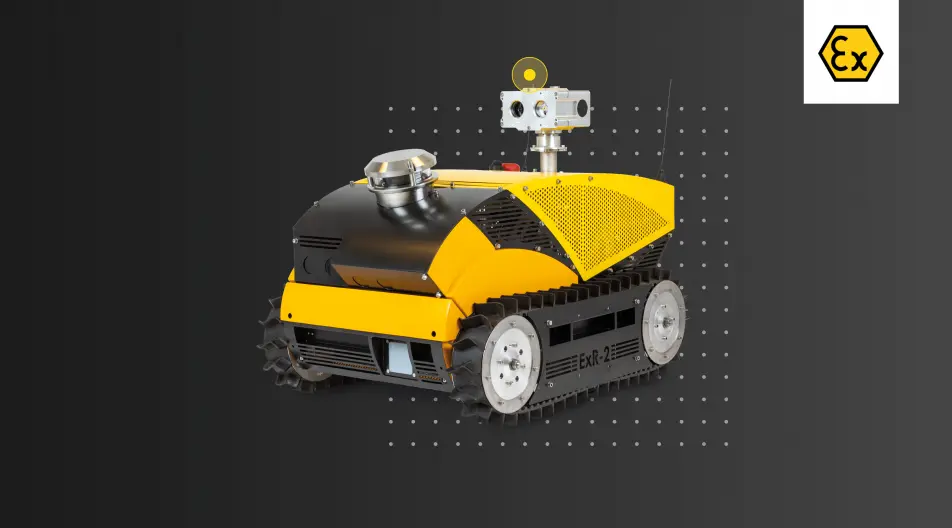August 23, 2021
NON-ELECTRICAL RISKS IN EX ENVIRONMENTS
In recent years robot operators have started to appear at oil and gas facilities around the World. These robots have been designed to operate safely in potentially explosive gas environments and are certified to Ex standards such as ATEX and IECEx. Until recently these standards emphasised electrical safety, i.e., avoiding risks associated with sparks generated by electrical circuits. However, robots can generate non-electrical sparks/heat that could trigger a gas explosion. For example, a jammed bearing can generate frictional heat.

Recently introduced standards (EN ISO 80079-36 and -37) provide a structured approach to identify and control these “non-electrical” risks. Compliance with these standards has significant implications for the design and use of Ex Robot Operators.
An ignition hazard assessment is at the heart of the standards. This assessment requires that specific categories of risk are assessed and managed. This article reviews those categories that are likely to be of most relevance to Robot Operators.
HOT SURFACES
Friction is one of the major risk factors in this category. As has already been mentioned, damaged bearings are a potential source of friction. The robot designer must ensure that the risk of damaged bearings is minimised. Other sources of friction might be foreign objects trapped in the drive train or robot tracks rubbing against track guides.
Another, less obvious source of heat relates to the induction chargers used by some robots. It’s possible that foreign objects trapped between the charging plates could overheat. Robot designers will usually include foreign object detection to mitigate this risk.
However, robot designers cannot eliminate all risks. Robot Operating Companies need to assess and manage the residual risks. For example, robot routes should be cleared of items that might become trapped in the drive train and vegetation should be controlled around robot docking
stations with induction chargers.
MECHANICAL SPARKS
Even with the best collision avoidance software, there’s always a risk that a robot will hit part of the process plant, a barrier, a structural column or similar. The best way to mitigate this risk is to limit the robot’s speed so that the impact energy is insufficient to create a mechanical spark.
However, this doesn’t cover all eventualities. Drop-offs are especially hazardous. If a robot drives over a drop or falls down a stair its impact energy will be more than enough to create a spark. It may also critically damage any pipes or other parts of the process plant that it hits. Also, owing to their metallurgical character, different metals can create a spark at low impact energies. For example, robots may have aluminium housings that impact on steel structures.
Again, the robot operating company has a role to play. They must assess and mitigate these risks. For example, it may not be acceptable for robots to drive up and down stairs or to approach unprotected drop-offs
Individual robot components also need to be designed to avoid mechanical sparks. For example:
- When a robot mast is raised it can hit an overhead obstacle. Metal studs or linkages in the drive train can impact metal items on the ground. The solutions are likely to be a combination of limited impact energy and controlled metallurgy.
- Jammed gears can impact on each other. Limiting their speed will eliminate the risk.
- High energy springs can break and release energy. The solution is to minimise the risk of breakage and/or to contain the released energy.
- Tyres or tracks may eject stones and debris that impact on metallic items of the plant.
- Limiting the robot’s speed eliminates this risk.
Reduced speed and impact energy is a recurring theme in this category. In the interests of safety, Robot Operating Companies may need to curtail their desire for faster robot operators. This is no different than the limitations that have been imposed on human operators for many years.
STATIC ELECTRICITY
Static electricity has always been a consideration when designing robot operators. Surface based robots (not drones) often use an equipotential bonding system that conducts static electricity to the ground. However, the ignition hazard assessment will reveal that the equipotential bonding system will be ineffective if the ground in very dry environments is nonconductive. There’s little that the robot designer can do in this case, so the responsibility passes to the robot operating company.
CHEMICAL REACTION
Most robots only contain chemicals in their batteries and usually the battery certificates and robot tests provide sufficient confidence that they won’t generate excessive heat. However, some Ex Robot Designers avoid using lithium batteries because of their history of catastrophic failure and because of the limitations imposed by the Ex electrical standards.
CONCLUSION
Although non-electrical considerations complicate things, carefully designed robots can still operate safely in potentially explosive gas environments when Robot Operating Companies manage the residual risks.
